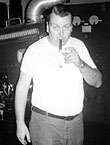|
|
 
|
|
Author
|
Topic: Grounding Issues with some Smart Products
|
|
|
Gordon Bachlund
Jedi Master Film Handler

Posts: 696
From: Monrovia, CA, USA
Registered: Aug 1999
|
 posted 06-10-2005 01:53 PM
posted 06-10-2005 01:53 PM





Gordon, as we both know all too well, grounding is an important life and fire safety issue. Accordingly, it is always wise to insist that all components bought in the US bear the UL label, as such labeling ensures that the design and manufacture of the equipment conforms to UL requirements, including proper bonding and grounding.
Did the Smart equipment you installed bear the UL label? If so, and these defects were as observed, UL should be notified of the glitch so they can take corrective action with the manufacturer. If not, I would question why the equipment was purchased at all.
In today’s market, much electronic equipment is imported, either as completed components or as parts for final assembly in the US. This situation can lead to the sort of problem that you experienced.
It is inexcusable that a few dollars saved at the manufacturer’s end wound up costing you many dollars in the field. ![[Mad]](mad.gif)
| IP: Logged
|
|
|
|
|
|
|
|
|
|
|
|
Frank Angel
Film God

Posts: 5305
From: Brooklyn NY USA
Registered: Dec 1999
|
 posted 06-12-2005 06:51 AM
posted 06-12-2005 06:51 AM





quote: Gordon Bachlund
Gordon, as we both know all too well, grounding is an important life and fire safety issue. Accordingly, it is always wise to insist that all components bought in the US bear the UL label, as such labeling ensures that the design and manufacture of the equipment conforms to UL requirements, including proper bonding and grounding.
Let me tell you a little about that UL Approved label. It was on all the UPS and the surge protector strips we had, all of which were from reputable manufacturers -- Smart, Tripplite, and others. In our theatre complex, Con Ed (our electric company) supplies unusually high voltage -- we have monitors on the mains into the racks that only rarely read below 125v and most times 128v to 132v. That's high. But here's the dirty little secret about surge protector circuits -- they age. And the higher number and the severity of the spikes they suppress, will make them age faster of slower. But not matter, they always age and as they do so, the clamping voltage threshold drops. Since our voltage is generally high, sooner or later the clamping voltage threshold and the line voltage input cross. At that point the surge protection circuit goes into clamp mode -- constantly. Then comes a real spike which causes the innards of the surge protector to freakin burst into flames. I kid you not. On some, fire actually shot out of the edison sockets -- one of our older secretaries nearly fainted and had heart palpitations when the one right on her desk hissed and shot flames and smoke out the sockets, blistering one of the line cords that was plugged into it. Given where most of those surge protectors wind up living -- under desks, on desks with combustible crap all around them, this is a combination for disaster.
One of our largest UPS units with a huge battery -- something like 50 pounds -- burst into flames and even after it was unplugged and doused with a fire extinguisher, the flames extinguished for a few seconds and then it started right back up again. i.e., self-fueling and not about to be extinguished by normal means. It continued to burn and spew noxious fumes as we tried to drag it by its cord out of the building. After three of the UPS and four of the surge suppressors "flamed out" as we call it, I went to every suppressor strip and opened them up to find all of them had charred crispy critter components -- some so bad that the disc caps had their encasement material disintegrated into black charcoal. These were all UL Approved....to insure safety and prevent FIRE....lucky for us, huh?!!
I later discovered that, yes indeed, the surge protector strips and the UPS UL spec had a flaw -- that's what they call a piece of hardware that can burst into flames without warning....a flaw). Underwriters Laboratory has since revised their specs on surge protectors to include some kind of thermistor or something called a MOV that will sense overheating and protect the circuit, or so I'm told. Thing is, UL they never recalled the millions of units WITHOUT that super important, potentially life-saving component, so you never know when you buy one of these innocent-looking surge protectors strips, if it will burst into flames on you or one that follows the "improved" UL Approval spec.
So much for the UL Approved label.
| IP: Logged
|
|
|
|
|
|
|
|
|
|
|
|
|
|
All times are Central (GMT -6:00)
|
|
Powered by Infopop Corporation
UBB.classicTM
6.3.1.2
The Film-Tech Forums are designed for various members related to the cinema industry to express their opinions, viewpoints and testimonials on various products, services and events based upon speculation, personal knowledge and factual information through use, therefore all views represented here allow no liability upon the publishers of this web site and the owners of said views assume no liability for any ill will resulting from these postings. The posts made here are for educational as well as entertainment purposes and as such anyone viewing this portion of the website must accept these views as statements of the author of that opinion
and agrees to release the authors from any and all liability.
|

 Home
Home
 Products
Products
 Store
Store
 Forum
Forum
 Warehouse
Warehouse
 Contact Us
Contact Us




 Printer-friendly view of this topic
Printer-friendly view of this topic







![[Mad]](mad.gif)


![[Cool]](cool.gif) One circuit in Brazil had a rule that if any non-tech opened a rack, they where canned....their locations had less sound problems and missing hardware
One circuit in Brazil had a rule that if any non-tech opened a rack, they where canned....their locations had less sound problems and missing hardware ![[Wink]](wink.gif)





![[evil]](graemlins/evil.gif) until the voltage was dropped slightly. They even had a QSC amp act like a flame throwner once when it blew
until the voltage was dropped slightly. They even had a QSC amp act like a flame throwner once when it blew 


